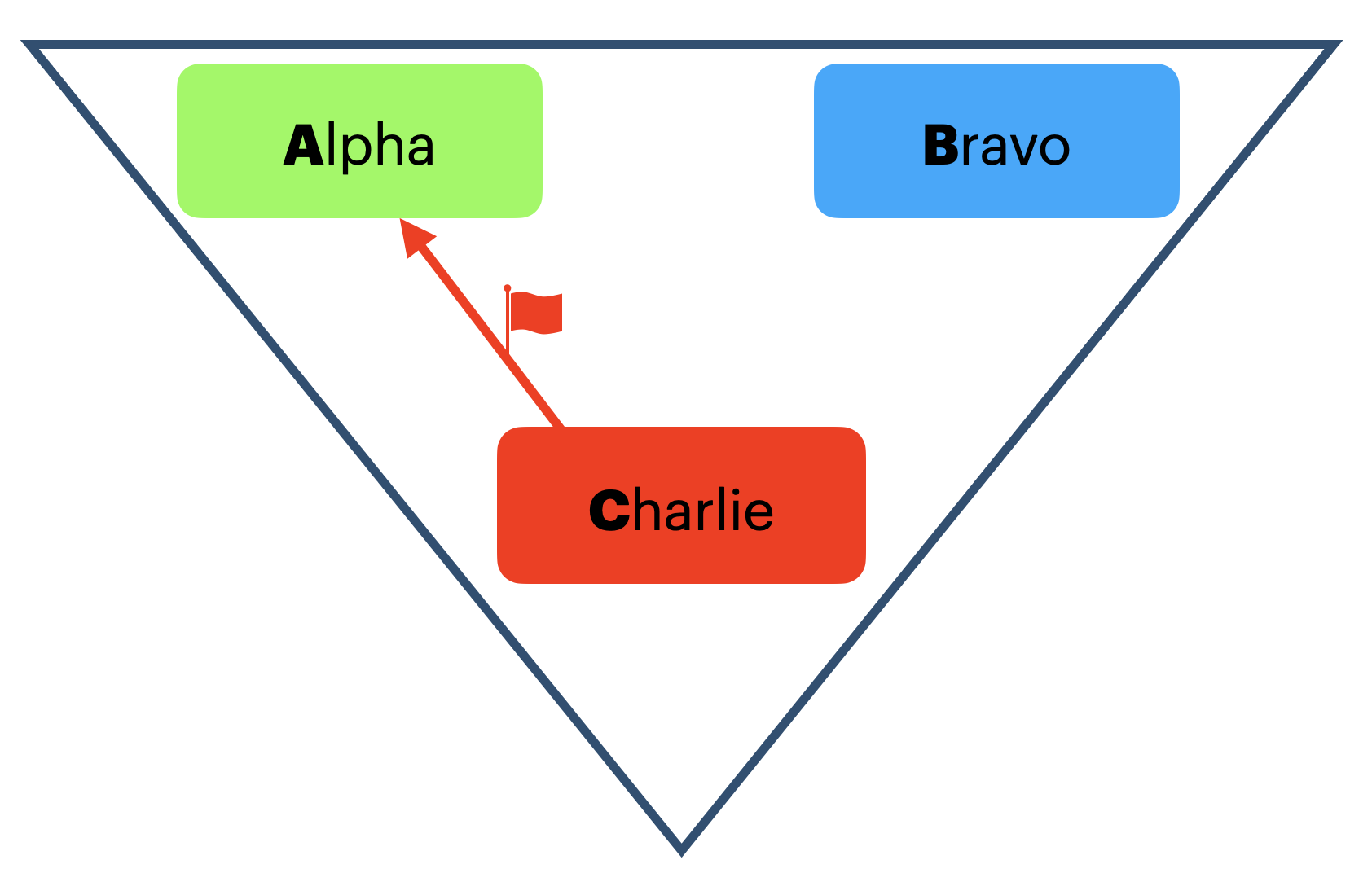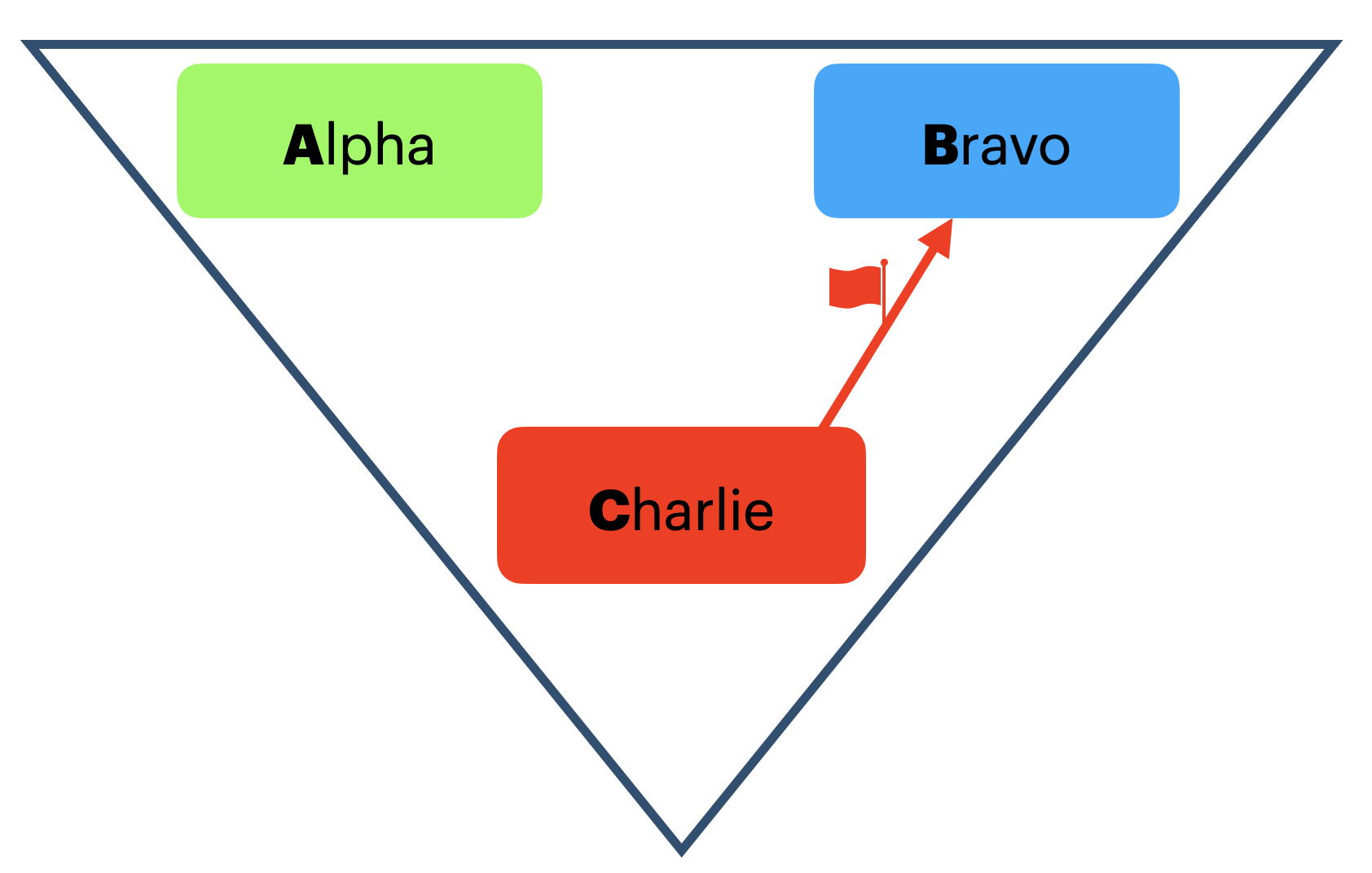Ever heard the advice, "Never use a team of 3"? It’s not just a random rule—there's a solid reason behind it. The issue is something called: Triangulation.
As the name suggests, Tri-angulation happens when 3 people are involved.
So a team of 3 is fertile grounds for triangulation to happen. But Triangulation can also happen in a team of 2.
Triangulation can erode team trust and effectiveness with the team wondering:
Why is there so much chaos?
Why is nothing ever simple?
Understanding triangulation helps you identify and address it, minimizing its corrosive effects on your team..
To better understand Triangulation, let’s look at some specific examples of Triangulation in both teams of 2 and 3.
Example: Triangulation in a Team of 2
Imagine of team with 2 team mates:
Bravo
Charlie
Bravo and Charlie often do not agree on the best course of action for their two person team. Sometimes this results in a stalemate. To gain more control over the team, Charlie turns to triangulation. To shift the power dynamic, Charlie tries to pull in a third party: Alpha—who is not on the team.
Charlie might jokingly ask, “Alpha, what do you think? I’m right, aren’t I?”
Now, it Bravo versus Charlie (+ Alpha), shifting the power dynamic.
When one team member unnecessarily inserts a third member into the interactions of a team of 2, this is a red flag. Beware.
On the other hand, if Alpha is not aware of triangulation, they may try to be a peace keeper and mediate between Bravo and Charlie. However, Charlie and Bravo then might turn against Alpha.
Triangulation can result in unexpected chaos with team members wondering what has happened to the team.
Example: Team of 3 Healthy Communication
To understand triangulation in a team of 3, let’s first see what healthy communication in a team of 3 looks like.
Imagine a team with 3 team mates:
Alpha
Bravo
Charlie
Alpha knows both Bravo and Charlie, who don’t know each other well. So Alpha tries to foster connection between Bravo and Charlie by highlighting their common interests or needs. The goal of Alpha is to build team connections and healthy communication between team members.
Notice in the diagram for healthy team communication that all three team mates are communicating openly.
Example: Triangulation in a Team of 3
Now, let's dive into triangulation in a team of 3.
Again, imagine a team with 3 team mates:
Alpha
Bravo
Charlie
In order to shift the power dynamics of the team of 3, Charlie turns to triangulation.
First, in a good natured manner, Charlie deftly makes a subtle negative comment about Bravo to Alpha:
"Bravo's only been doing this for two years. Can we really expect more from Bravo?"
Notice the artfulness of Charlie’s comment. His comment still gives Charlie the opportunity to say he is not being negative toward Bravo, but the comment still has the effect of “poisoning the well” for Bravo. This is a red flag.
Next Charlie makes a similar move with Bravo:
"Alpha's always trying to connect people—or control everything, right?" Then Charlie chuckles in a good natured manner.
Once again, Charlie can argue that his comment is not negative. Yet the comment can still have the effect of “poisoning the well” but this time for Alpha. Once again, a red flag.
Notice how Charlie tries to use subtle negativity to create friction between Alpha and Bravo, triangulating the team. Also notice that these subtle, but negative, comments often begin positively but end on a subtle negative note. Furthermore, those adapt at triangulation, such as Charlie, if called out, will often dismiss it as a joke, asking “Where’s your sense of humor?”
Why Would a Team Member, such as Charlie, Use Triangulation in a Team of 3?
Clearly, Charlie is using triangulation to shift the power dynamics of the team in his favor.
If Charlie has a dispute with Alpha, Charlie will pull Bravo into the dispute on his side against Alpha. Charlie has already tried to poison the well against Alpha. “Bravo and I both see Alpha’s controlling side.” This makes it 2 (Charlie and Bravo) against 1 (Alpha).
If Charlie has a dispute with Bravo, then he can pull Alpha into the dispute against Bravo. Again, Charlie has already tried to poison the well against Bravo. “Alpha and I both know Bravo’s not that capable.” Once again, this makes it 2 (Charlie and Alpha) against 1 (Bravo).
Pivoting between his allies, Charlies always wins with 2 team mates against 1.
As you can see, triangulation provides the triangulator with a temporary advantage. Bravo doesn’t know what Charlie has said to Alpha about him. Alpha doesn’t know what Charlie has said to Bravo about him. Often team mates are reluctant to share negatives being said about someone else so the team mates remain in the dark. And Charlie gains a temporary advantage. This keeps teammates in the dark about the true team dynamics.
Triangulators must work diligently to ensure that others do not start seeing through the triangulation. Sometimes the negativity is so subtle that team members may not realize until years later that they were the victims of triangulation.
How To Detect Triangulation?
The key to unraveling triangulation is to:
1. Be alert for subtle negative comments about teammates. If Charlie is making subtly negative comments about Bravo to Alpha, he’s likely doing the same to Bravo about Alpha. Masters of triangulation are adept at subtle negative comments so your radar has to be finely tuned for this or you can completely overlook it.
2. Be aware of communication patterns that exclude 1 of the 3 team mates. Triangulation rarely works if all three team members are involved in open communication at the same time. Triangulation thrives on excluding one of the three team members. If one person is always left out of conversations, it's a red flag.
What To Do When Faced with A Triangulated Team?
Actions to consider when faced with a triangulated team include:.
1. Inclusive Communication. Ensure all members are included in team communications. No one should be left out.
2. Call It Out. If a team member continues to use triangulation, address it openly in front of all 3 team members. For example, “Hey Charlie, remember when you said we shouldn’t expect much from Bravo? Turns out, he has more experience than you!”
3. Disband the Team If Necessary. If a team member continues to use triangulation, consider disbanding the team. It might sound harsh, but it’s better to focus energy on productive teamwork than monitoring underhanded behavior. When reforming the team, opt for groups of 2 or 4 to avoid this issue.
Triangulation Effects on Team Trust and Effectiveness
Triangulation can quietly erode team trust and effectiveness. By staying vigilant and fostering open communication, you can keep your team strong and cohesive.
Got any stories or tips about dealing with triangulation? Share them below!




